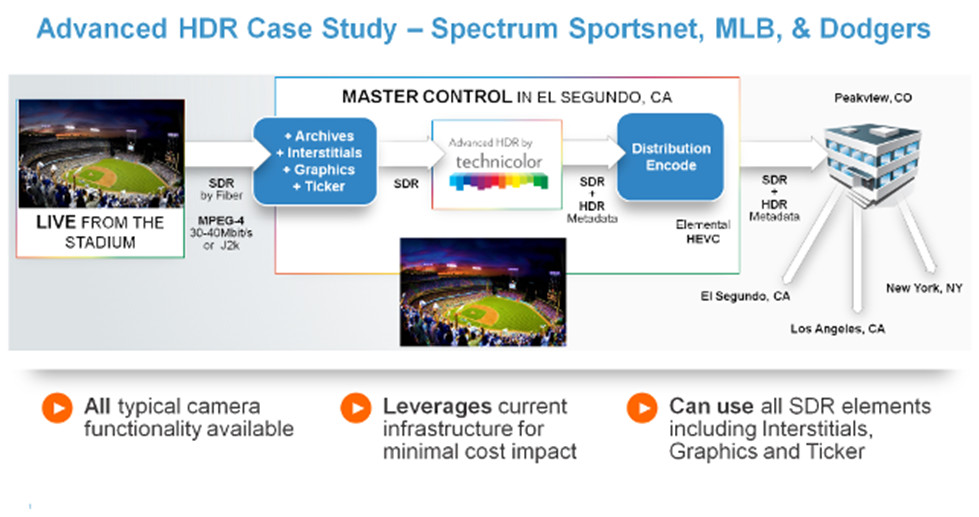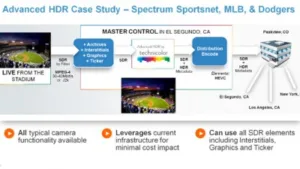We had a chance to meet with Technicolor in their suite to get an update on their HDR workflow, which is geared for broadcast production. Called Advanced HDR by Technicolor, the idea is to allow a mixture of SDR and HDR cameras for a live production using several HDR EOTFs (HLG, S-Log3, PQ10 (PQ ST2084 without metadata). All SDR sources are upconverted to HDR for programming and switching. Just prior to the final encoder, the HDR is analyzed by a Technicolor box to create an SDR signal with metadata that can be used at the decoder to reconstruct the HDR signal. If the received device does not have the Advanced HDR by Technicolor decoder, the metadata is ignored and an SDR signal displayed.
This approach allows capture, production and archiving in a higher HDR format, and provides a deliverable to the vast SDR installed base. The first HDR capable sets with the Technicolor technology will come later this year from LG Electronics.
The downside is that devices that support HLG, HDR10, HDR10+ or Dolby Vision can’t take advantage of this signal. As a result, the broadcaster may have to decide if they also want to send out an HLG or HDR10 version of the live content as well. Such versioning is not very desirable, obviously.
However, a key benefit of the Technicolor HDR distribution format is encoding efficiency, they claim. Josh Limor, VP of Technology and Ecosystem Development at Technicolor, told us that Technicolor HDR can be compressed 25% more than HDR10 and 40% more than HLG for comparable image quality.
Technicolor recent completed a live broadcast of a basketball game between the LA Lakers and the Denver Nuggets, working with Spectrum SportsNet. For the telecast, SDR and HDR cameras were used with Sony’s S-Log 3 gamma in the camera, which was also directly fed to monitors for preview. At Master Control in El Segundo, all SDR content, including commercials, archival content and interstitials, were upconverted to S-Log3 HDR using Technicolor’s Intelligent Tone Mapping technology. The program was cut and previewed all in Sony’s S-Log3 HDR. The Advanced HDR technology was also used prior to the final encoder to then create the SDR version with metadata. An Elemental encoder then created a standard HEVC encoding of the SDR signal with the metadata embedded in the SEI part of the stream, for viewing in several locations. Technicolor says that Ateme and Harmonic encoders work well too.
 Technicolor’s workflow allows all production in HDR then conversion to SDR + metadata
Technicolor’s workflow allows all production in HDR then conversion to SDR + metadata
This experiment also created a clean HDR S-Log3 version, which could be converted to HLG or PQ for distribution as a dedicated HDR feed (although not shown). As we describe elsewhere, a number of HDR-to-HDR converter boxes were debuted at NAB to facilitate this if desired.
Technicolor also showed a comparison of an HDR10 signal compared to the Advanced HDR by Technicolor signal on identical HDR TVs. Not only is the Technicolor signal more efficient, but it did a better job of reducing artifacts around the graphics edges and eliminating some magenta hue shifts on the basketball court with HDR10.
Limor says that encoding in SDR with gamma and adding the metadata is actually a better way to go vs. encoding with PQ. He said that PQ does not have enough bits for the higher luminance parts of the image, which he thinks explains the above described artifacts.
Technicolor decoding technology will also be coming to set top boxes soon with the ICs from RealTek, mLogic and Marvel ready to go. – CC

